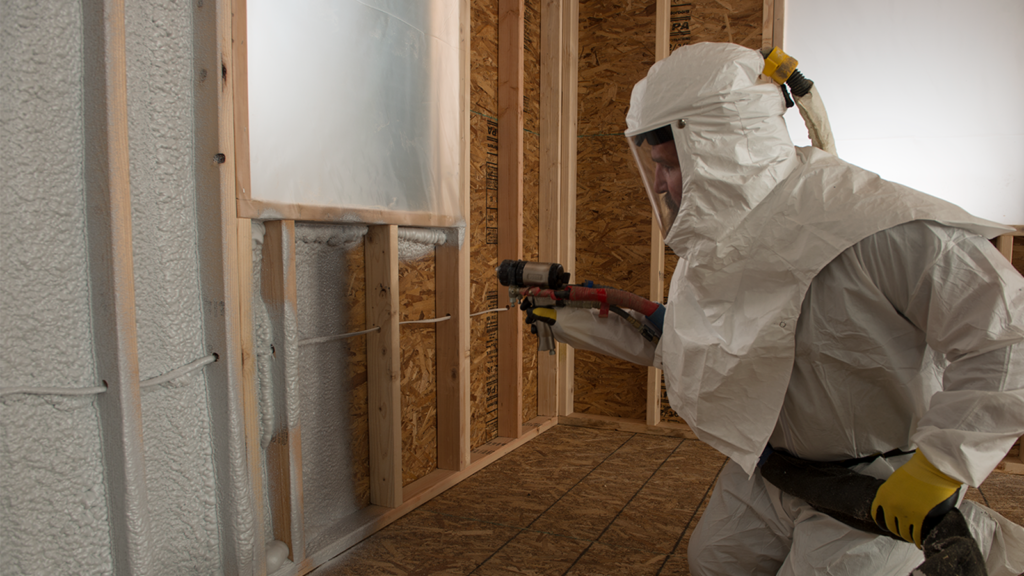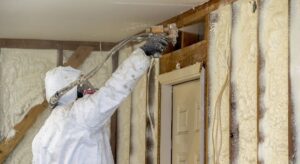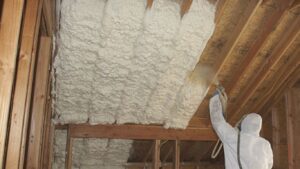
Insulation plays a pivotal role in ensuring comfort and energy efficiency within homes and buildings. Among the myriad insulation options available, spray foam insulation stands out as a highly effective solution. Its ability to create an airtight seal and provide exceptional thermal resistance has made it a top choice for property owners seeking to reduce energy consumption and maintain a comfortable indoor environment. However, the decision to insulate with spray foam comes with an important choice: closed-cell vs. open-cell. In this article, we delve into the distinctions between these two spray foam insulation types, aiding you in making an informed decision that suits your specific needs and circumstances.
Understanding Spray Foam Insulation
Spray foam insulation is a revolutionary solution that creates an airtight seal by rapidly expanding when applied. It combines isocyanate and polyol resin, forming a foam substance that fills gaps and cracks, controlling temperature and enhancing energy efficiency. Spray foam offers superior thermal resistance and air sealing, preventing heat loss and air infiltration, resulting in energy savings and a comfortable indoor environment. It eliminates drafts and fluctuating temperatures, ensuring a cozy indoor environment year-round.
Energy Efficiency in Odessa, TX
Nestled in the heart of West Texas, Odessa experiences climate and weather patterns that pose unique challenges when it comes to energy efficiency. Understanding the local climate and its impact on energy consumption is crucial for residents and businesses seeking ways to reduce their energy bills and environmental footprint.
Climate and Weather Patterns in Odessa
- Extreme Temperatures: One defining characteristic of Odessa’s climate is the extreme temperature range it encounters throughout the year. Summers can be scorching hot, with temperatures frequently soaring above 100°F (37.8°C). Conversely, winters bring chilly nights, sometimes dropping below freezing. These extreme temperatures can put a heavy burden on heating and cooling systems, leading to increased energy consumption.
- Seasonal Variations: Odessa also experiences notable seasonal variations. While summer months are sweltering, winters can be relatively mild during the day but much colder at night. This fluctuation in temperature necessitates the use of both heating and cooling systems, contributing to higher energy demands.
Energy Consumption Challenges in the Region
- High Cooling and Heating Demands: With summer temperatures often exceeding 100°F, air conditioning becomes a necessity for comfort and safety. Cooling systems work tirelessly to combat the heat, driving up electricity bills. Similarly, during winter, heating systems must work overtime to keep indoor spaces warm, further increasing energy consumption.
- Impact on Utility Bills: The high cooling and heating demands in Odessa have a direct impact on utility bills. Residents and businesses can experience significant spikes in their energy costs during peak seasons. This financial strain can be a concern for many and underscores the importance of energy-efficient practices and technologies.
In light of these climate and energy consumption challenges, implementing energy-efficient measures such as proper insulation, smart thermostats, and efficient HVAC systems can make a substantial difference. By optimizing energy use and reducing waste, Odessa residents can not only save on their utility bills but also contribute to a more sustainable and eco-friendly community.
Closed-Cell Spray Foam Insulation
Closed-cell spray foam insulation is a popular, high-performance thermal insulating material. It’s created by mixing polyol resin and isocyanate under high pressure, resulting in a dense, rigid foam that seals surfaces tightly and expands minimally compared to open-cell foam.
Properties and Characteristics of Closed-Cell Insulation
- Density: Closed-cell foam is dense and compact, with a cellular structure that remains closed, preventing air infiltration. This density contributes to its outstanding insulating properties.
- R-value: Closed-cell insulation boasts a high R-value, typically ranging from R-6 to R-7 per inch of thickness. This indicates its exceptional ability to resist heat transfer, making it one of the most thermally efficient insulation materials available.
- Vapor Barrier Properties: Closed-cell insulation also acts as a vapor barrier. It inhibits moisture penetration, making it an excellent choice for areas prone to high humidity or potential water intrusion.
Pros of Closed-Cell Insulation
- High Insulation Value: Its impressive R-value provides superior thermal resistance, leading to reduced energy consumption and lower heating and cooling costs.
- Structural Strength: Closed-cell foam adds structural integrity to walls and roofs, increasing a building’s resistance to wind and seismic forces.
- Moisture Resistance: The closed-cell structure repels moisture, preventing mold and mildew growth and preserving the insulation’s effectiveness over time.
Cons of Closed-Cell Insulation
- Cost: Closed-cell insulation is relatively more expensive than open-cell foam or traditional insulation materials. The upfront cost can be a deterrent for some homeowners or builders.
- Installation Complexity: Proper installation of closed-cell insulation requires a skilled professional. The process can be more intricate due to the need for precise mixing, temperature control, and application.
Closed-cell spray foam insulation offers superior thermal performance, structural support, and moisture resistance, making it a worthwhile investment for homeowners and commercial property owners due to its long-term energy savings and durability.
Open-Cell Spray Foam Insulation
Open-cell spray foam insulation is an eco-friendly, versatile material that offers unique advantages for various applications. It is produced by mixing polyol resin and isocyanate, with its cellular structure remaining open and porous, allowing air and moisture to pass through. Its properties and pros and cons are explored.
Properties and Characteristics of Open-Cell Insulation
- Lower Density: Open-cell foam has a lower density compared to closed-cell foam. This results in a softer, more flexible material that expands significantly upon application.
- R-value: While open-cell insulation offers good insulation, it typically has a lower R-value than closed-cell foam, usually ranging from R-3.5 to R-4.5 per inch.
- Not a Vapor Barrier: Unlike closed-cell insulation, open-cell foam is not a vapor barrier. It allows moisture to pass through, which can be advantageous in certain situations.
Pros of Open-Cell Insulation
- Lower Cost: Open-cell insulation is more budget-friendly than closed-cell insulation, making it an attractive option for cost-conscious homeowners and builders.
- Excellent Sound Insulation: The open-cell structure of this foam lends itself well to soundproofing applications, reducing noise transmission between rooms and floors.
- Environmentally Friendly: Open-cell insulation typically has lower levels of volatile organic compounds (VOCs), making it a more environmentally friendly choice.
Cons of Open-Cell Insulation
- Lower Insulation Value: While it provides decent insulation, open-cell foam has a lower R-value compared to closed-cell foam, which means it may not be as effective in extremely cold or hot climates.
- Susceptibility to Moisture: Since open-cell foam allows moisture to penetrate, it may not be suitable for areas prone to water intrusion or high humidity, as it can become a breeding ground for mold and mildew.
Open-cell spray foam insulation is a cost-effective, eco-friendly solution for soundproofing, but its lower insulation value and moisture vulnerability necessitate careful assessment and consultation with a professional insulation expert.
Factors to Consider When Choosing
When it comes to choosing the right type of insulation, be it closed-cell or open-cell spray foam, several critical factors must be taken into account. Your choice should align with the unique needs and conditions of your project. Here, we explore the key considerations that will guide you toward making the most suitable decision:
- Climate and Location Considerations: The choice of insulation depends on the climate, with closed-cell insulation being preferred for colder climates due to its higher R-value and moisture resistance, while open-cell insulation is suitable for milder climates, considering humidity levels.
- Building Design and Usage: The design and purpose of your building significantly influence the choice of insulation. Closed-cell insulation may be beneficial for high-traffic commercial spaces, while open-cell insulation offers flexibility and soundproofing for interior walls.
- Budget Constraints: Choosing between closed-cell and open-cell insulation is crucial, with closed-cell being more expensive due to its superior properties, while open-cell offers a budget-friendly option. Despite higher upfront costs, closed-cell insulation offers long-term savings.
- Moisture Control Requirements: Assess your project’s moisture control needs, particularly in areas with flooding or high humidity. Closed-cell insulation can serve as a reliable moisture barrier, while open-cell insulation should be avoided in these situations.
- Installation and Maintenance Considerations: Closed-cell insulation requires professional installation due to its precision and density, while open-cell insulation is DIY-friendly. It also requires less maintenance due to its durability and moisture resistance.
Assessing closed-cell and open-cell spray foam insulation requires careful consideration of project requirements, strengths, and weaknesses. Consulting with insulation experts can provide valuable insights.
Application Scenarios
Selecting the appropriate type of spray foam insulation for your project is essential to ensure optimal performance and cost-effectiveness. Let’s explore the ideal application scenarios for both closed-cell and open-cell insulation:
Ideal Scenarios for Closed-Cell Insulation
Crawl Spaces:
- Closed-cell insulation excels in crawl spaces beneath your home. Its dense structure provides excellent thermal insulation and acts as an effective moisture barrier, protecting against dampness and mold growth. This is especially crucial in regions with high groundwater levels or frequent rain.
Exterior Walls:
- Closed-cell spray foam is a top choice for exterior walls due to its impressive insulating properties and structural strength. It enhances the structural integrity of your walls and creates a tight thermal envelope, minimizing heat loss and energy consumption.
High Moisture Areas:
- In areas prone to excessive moisture, such as coastal regions or spaces with high humidity levels, closed-cell insulation shines. Its ability to serve as a vapor barrier makes it an excellent choice for preventing moisture-related issues like mold, mildew, and rot.
Ideal Scenarios for Open-Cell Insulation
Interior Walls:
- Open-cell spray foam is an ideal choice for insulating interior walls. Its flexibility and sound-absorbing properties make it effective in reducing noise transmission between rooms, providing a quieter and more comfortable living or working environment.
Soundproofing Projects:
- Open-cell insulation is a popular choice for soundproofing applications, such as home theaters, recording studios, or even shared walls in multi-unit buildings. Its open-cell structure absorbs sound waves, minimizing noise transfer between spaces.
Budget-Conscious Projects:
- When budget constraints are a primary concern, open-cell insulation can be a cost-effective solution. It offers decent insulation properties while being more affordable than closed-cell foam, making it a practical choice for projects with limited financial resources.
Choose between closed-cell and open-cell spray foam insulation based on project needs. Closed-cell is ideal for high-value areas like crawl spaces and exterior walls, while open-cell is suitable for interior walls, soundproofing, and budget-conscious projects.
Installation and Maintenance
Installing and maintaining spray foam insulation is crucial for its long-term effectiveness. Both closed-cell and open-cell insulation follow a similar installation process, involving the precise mixing and expert application of the foam material. However, closed-cell insulation typically requires more precision due to its density.
Maintenance requirements differ between the two types. Closed-cell insulation is known for its durability and moisture resistance, requiring minimal maintenance. Open-cell insulation may necessitate more attention in high-moisture areas.
To ensure a successful installation and long-term performance, selecting a reputable insulation contractor is paramount. Look for experienced professionals with a proven track record, proper certifications, and a commitment to safety and quality workmanship.
In conclusion, Choosing between closed-cell and open-cell spray foam insulation can be a daunting decision. The problem lies in the complexity of selecting the right insulation type for your specific needs. The wrong choice could lead to inefficient insulation, higher energy bills, or even moisture-related issues.
However, we have the solution. Contact us or visit our website to connect with our insulation experts. We’ll assess your project requirements, climate conditions, and budget constraints to guide you towards the perfect insulation choice. Don’t let uncertainty leave you in the cold; reach out to us today for a tailored solution that ensures comfort and energy efficiency in your space.





